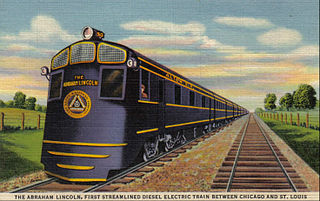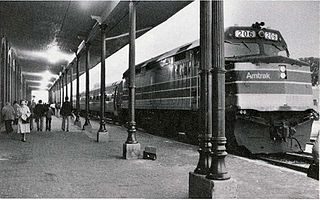
The Lake Shore Limited is an overnight passenger train operated by Amtrak between Chicago and the Northeastern United States, with sections to New York City and Boston. The central segment of the route runs along the southern shore of Lake Erie.

The Cardinal is a long-distance passenger train operated by Amtrak between New York Penn Station and Chicago Union Station via Philadelphia, Washington, D.C., Charlottesville, Charleston, Huntington, Cincinnati, and Indianapolis. Along with the Capitol Limited and Lake Shore Limited, it is one of three trains linking the Northeast and Chicago. Its 1,146-mile (1,844 km) trip between New York and Chicago takes 281⁄4 hours.

Michigan Services are three Amtrak passenger rail routes connecting Chicago, Illinois with the Michigan cities of Grand Rapids, Port Huron, and Pontiac, and stations en route. The group falls under the Amtrak Midwest brand and is a component of the Midwest Regional Rail Initiative.

The Empire State Express was one of the named passenger trains and onetime flagship of the New York Central & Hudson River Railroad. On September 14, 1891, it covered the 436 miles (702 kilometers) between New York City and Buffalo in 7 hours and 6 minutes, averaging 61.4 miles-per-hour (98.8 km/h), with a top speed of 82 mph (132 km/h).

The International was a named passenger train operated between Chicago and Toronto. It was originally an overnight train operated by the Grand Trunk Railway of Canada and its successors the Canadian National Railway and Grand Trunk Western Railroad, running as far as Montreal. The train was cut back to Port Huron, Michigan, in 1970 and discontinued in 1971.

The Turboliners were a family of gas turbine trainsets built for Amtrak in the 1970s. They were among the first new equipment purchased by Amtrak to update its fleet with faster, more modern trains. The first batch, known as RTG, were built by the French firm ANF and entered service on multiple routes in the Midwestern United States in 1973. The new trains led to ridership increases wherever used, but the fixed consist that made up a Turboliner train proved a detriment as demand outstripped supply. The high cost of operating the trains led to their withdrawal from the Midwest in 1981.

The Wolverine is a higher-speed passenger train service operated by Amtrak as part of its Michigan Services. The 304-mile (489 km) line provides three daily round-trips between Chicago and Pontiac, Michigan, via Ann Arbor and Detroit. It carries a heritage train name descended from the New York Central.

The Pere Marquette is a passenger train operated by Amtrak as part of its Michigan Services on the 176-mile (283 km) route between Grand Rapids, Michigan, and Chicago, Illinois. It is funded in part by the Michigan Department of Transportation and is train 370 eastbound and train 371 westbound. The westbound train leaves Grand Rapids during the morning rush, with the eastbound train leaving Chicago after the afternoon rush, enabling same-day business travel between the two cities.

The Blue Water is a higher-speed passenger train service operated by Amtrak as part of its Michigan Services. The 319-mile (513 km) route runs from Chicago, Illinois, to Port Huron in Michigan's Blue Water Area, for which the train is named. Major stops are in Kalamazoo, Battle Creek, East Lansing, and Flint.

The Twin Zephyrs, also known as the Twin Cities Zephyrs, were a pair of streamlined passenger trains on the Chicago, Burlington and Quincy Railroad (CB&Q), running between Chicago and the Twin Cities of Minneapolis and Saint Paul in Minnesota. It was the second Zephyr service introduced by CB&Q after the record-setting Denver–Chicago "dawn to dusk dash" of the Pioneer Zephyr trainset.

Michigan City station was a train station in Michigan City, Indiana served by Amtrak, the national railroad passenger system. It was served by two eastbound and one westbound Wolverine train at the time of closure; other Wolverine and Blue Water trains did not stop. The station had a platform shelter near the former prairie-style Michigan Central Railroad depot dating from 1915, which is now a local restaurant. That earlier station served Michigan Central Railroad, and later, New York Central passenger trains. Major NYC named trains passing through the station included the Canadian, the Chicago Mercury and the Wolverine.

The Abraham Lincoln was a named passenger train operated by the Baltimore and Ohio Railroad from 1935 into the 1960s. The Abe Lincoln ran between Chicago and St. Louis on the B&O's subsidiary Alton Railroad. The train later passed to the Gulf, Mobile and Ohio Railroad, and then finally to Amtrak, which retained the name until 1978. Service between Chicago and St. Louis is now known by the umbrella term Lincoln Service. This train was the first streamlined passenger service to travel the 284 miles between Chicago and St. Louis, with Joliet, Bloomington-Normal, Springfield and Alton in between. Passengers can get a glimpse of the Mississippi River between Alton and St. Louis.

Mercury was the name used by the New York Central Railroad for a family of daytime streamliner passenger trains operating between midwestern cities. The Mercury train sets were designed by the noted industrial designer Henry Dreyfuss, and are considered a prime example of Streamline Moderne design. The success of the Mercury led to Dreyfuss getting the commission for the 1938 redesign of the NYC's flagship, the 20th Century Limited, one of the most famous trains in the United States of America.

The James Whitcomb Riley was a passenger train that operated between Chicago, Illinois, and Cincinnati, Ohio, via Indianapolis, Indiana. Originally operated by the New York Central Railroad, it was taken over by Amtrak in 1971. Under Amtrak, it merged with the Chesapeake & Ohio Railway's George Washington to become a Chicago-Washington/Newport News train. In 1977, it was renamed the Cardinal, which remains in operation.

The Michigan Executive was a commuter train operated by Amtrak between Detroit, Michigan, and Jackson, Michigan. Amtrak took over the service from Penn Central in 1975 and discontinued it in 1984.

The Lake Shore Limited was a passenger train service operated by the New York Central Railroad between New York City and Chicago, Illinois, from 1897 to 1956. Separate sections linked to Boston and St. Louis. The Lake Shore Limited was the New York Central's first luxury passenger train, and paved the way for its more famous cousin the 20th Century Limited. The 1897 name is now used by Amtrak's Lake Shore Limited, which follows much the same route.

SEMTA Commuter Rail, also known as the Silver Streak, was a commuter train operated by the Southeastern Michigan Transportation Authority (SEMTA) and the Grand Trunk Western Railroad between Detroit and Pontiac, Michigan. It began in 1974 when SEMTA assumed control of the Grand Trunk's existing commuter trains over the route. SEMTA discontinued operations in 1983. Amtrak began offering intercity service between Detroit and Pontiac in 1994 as part of its Michigan Services.

The Maple Leaf was a passenger train pool operated by the Canadian National and the Grand Trunk Western Railroad between Chicago, Illinois and Toronto, Ontario. It operated from 1927 to 1971. The train took its name from the maple leaf, the national symbol of Canada. The Maple Leaf was one of many trains discontinued when Amtrak began operations in 1971, and is unrelated to the Maple Leaf which Amtrak now operates between Toronto and New York City. The train operated on Canadian National railroad territory through Ontario, but west of Lake Huron it operated via Grand Trunk Railroad.
The Wolverine was an international night train that twice crossed the Canada–United States border, going from New York City to Chicago. This New York Central Railroad train went northwest of Buffalo, New York, into Canada, traveled over Michigan Central Railroad tracks, through Windsor, Ontario, reentering the United States, through Detroit's Michigan Central Station, and on to Chicago. At the post-World War II peak of long-distance named trains, there were three other New York Central trains making this unusual itinerary through Southwestern Ontario. In the late 1960s, this was the last remaining train taking this route, failing to survive into the Penn Central era. The name resurfaced on the truncated Detroit–Chicago route with Amtrak's Wolverine.
The Canadian and later, Canadian-Niagara, was the longest running named international train from Chicago to Upper Canada via Detroit, for its first two decades running to Montreal. This overnight train was operated by the Michigan Central Railroad from Chicago to Detroit, and in a pool arrangement, it operated over Canadian Pacific Railway tracks and used the same train number from Detroit eastward. The train would carry a second section, bound, variously for Buffalo or New York City via Buffalo.


















